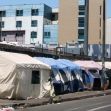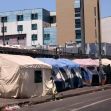As the homeless crisis in California continues to mount, the state legislature and the governor's office are finding themself inundated with demands for a solution.
Over the last five years, failed attempts to stop the growth of homelessness coupled with the effects of the pandemic have led to frustration in residents of cities hit the hardest. Los Angeles’ skid row has seen a rapid expansion with a growing number of encampments while the iconic Venice Beach has become somewhat unrecognizable as encampments have taken over the strip, open grassy areas, and even the beachfront. Beautiful boardwalk views that diners on the boardwalk once enjoyed are now replaced with unsightly tents, mattresses, furniture, and other possessions the homeless have accumulated over the past year.
A suspension of enforcement of outdoor camping regulations due to the pandemic has meant that strict guidelines that helped deter homelessness have now increased public safety concerns. The result has been a rise in fires breaking out, scattered needles and other drug paraphernalia, and a rise in crime.
Rapid Rise in Homelessness Despite State and Federal Aid
Over the past three years, the state has spent a whopping $13 billion trying to combat homelessness. But many have argued that the money has gone undetected by both agencies who were supposed to utilize that money and the homeless population itself.
California's state auditor, Elaine Howle, explained in a statement that the state’s rising homeless population is due “likely in part because its approach to addressing homelessness has been disjointed.” While money has been put toward the homeless crisis, homeless populations continue to increase with 2019 seeing a 16% jump from the previous year. After the pandemic hit in early 2020, the numbers peaked at an estimated rise from 150,000 to 161,000 as the pandemic left many unemployed and unable to pay their rent.
In a letter sent to the state legislature and Gov. Gavin Newsom, Howle calls for transparency in how funding for this issue is handled. Howle shares of the growing number, “Given the magnitude of the homelessness crisis in California and the amount of funding the state and federal governments commit to combating it, the state needs to ensure that its system for addressing problems ... is coherent, consistent, and effective.” Forty-one agencies were recipients of the $13 billion, yet without adequate tracking, it's unclear where the money has gone and why homelessness continues to be rampant.
What Has Caused the Surge in Homelessness?
Analysts argue that the crisis has been years in the making, and unlike other states like Oregon and Texas where homelessness exists but is attended to, California's crisis has grown to a point where resources have become inundated and stretched thin. Coupled with the lack of adequate access to mental health services, many who find themselves in homelessness are unable to get out. The National Coalition for the Homeless estimates that up to a quarter of homeless individuals suffer from debilitating mental illnesses that stand in their way of reintegrating into society. The NCH explains that for many, mental illness paves the way for self-medication and substance abuse to exist. They explain that the “combination of mental illness, substance abuse, and poor physical health makes it very difficult for people to obtain employment and residential stability.
California's economy and high cost of living are only working to muddle the situation. California tops the nation with the highest income tax at 13.3%. Coupled with a lack of affordable housing and a median house price of over $712,500, many residents find themselves struggling to keep a roof over their heads. According to a state database, 250,000 individuals worked with housing services to find affordable housing placements, but of that quarter of a million, 92,000 individuals were still unable to get support. For the lucky few who could leave the state, they have. With the pandemic allowing many to work from home, California saw a population change in the negative after over 650,000 residents left the state.
Newsom Announces Billion Dollar Plan To Tackle Homelessness
In a historic move, Governor Gavin Newsom announced in early May that $12 billion from the state's $100 billion California Comeback Plan will go toward combating the homeless crisis. According to the governor’s office, the money will help create 46,000 new housing units, and 65,000 people will benefit from housing placements.
Newsom explains that this new plan will come with "greater accountability and transparency measures" in order to keep track of where funding goes so that the housing crisis is actually addressed compared to previous failed attempts. This new outline details where sums of money will go with a majority ($7 billion) going toward its Homekey program that has helped create affordable housing units for the homeless population.






